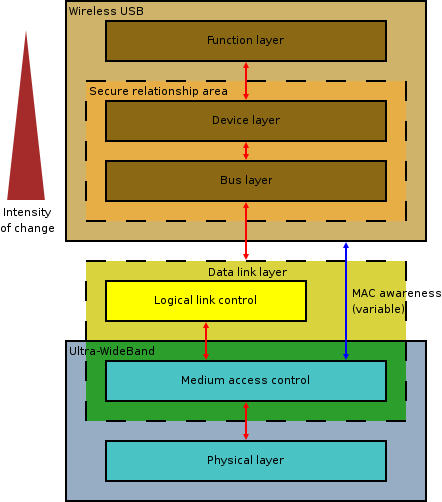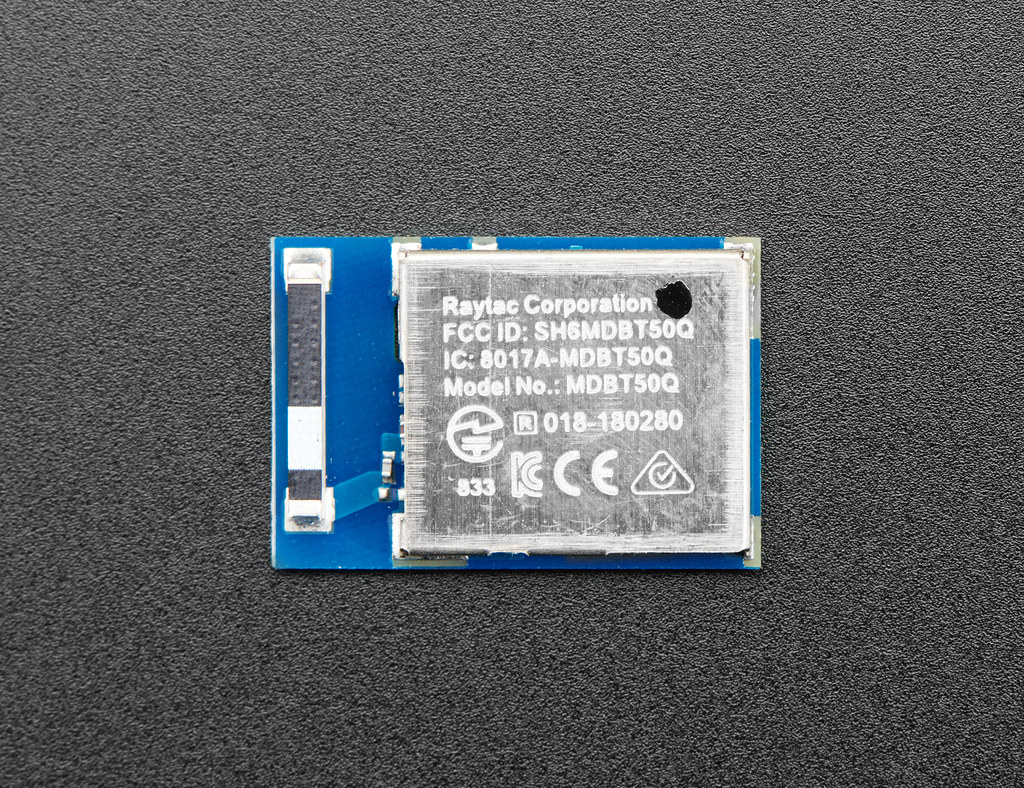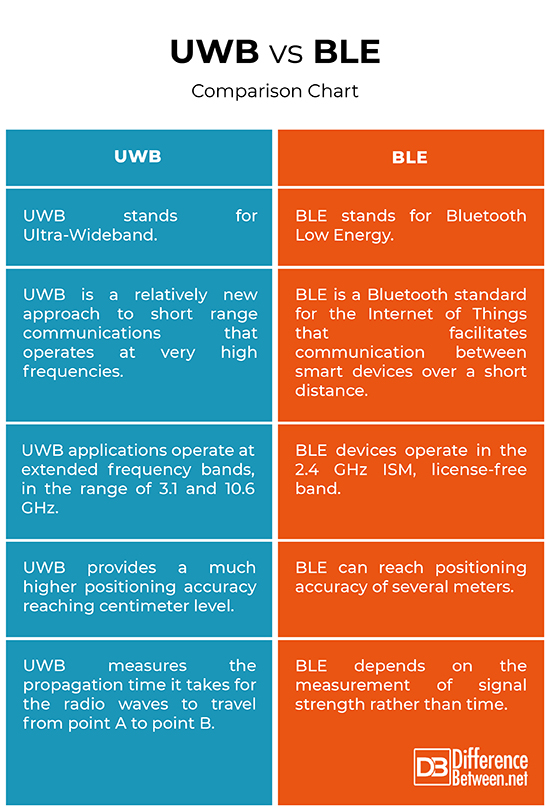Difference Between UWB and BLE
The advances in principal technologies and the proliferation of the Internet have helped accelerate the growth of the Internet of Things (IoT). And with the rise of Internet of Things, several key areas have seen a surge in indoor positioning systems, especially at homes, hospitals, and high-security zones. The current COVID-19 pandemic has already forced the majority of the world population into working from their homes, which brings in the matter of home security. Traditional indoor positioning systems haven’t been that reliable when it comes to positioning accuracy. Two ubiquitous technologies that have gained significant traction in the context of indoor positioning are Ultra-Wideband (UWB) and Bluetooth Low Energy (BLE). We compare the two technologies on various grounds to determine their potential for indoor positioning and other key application areas.

What is UWB?
Like Bluetooth and Wi-Fi, ultra-wideband (UWB) is a radio technology that uses short pulse radio waves to achieve high bandwidth connections. It is a relatively new approach to short range communications that operates at very high frequencies – it is able to send and receive data at bandwidths of over 500 megahertz at very low power spectra densities, unlike its counterparts. It has other attributes such as range finding and high power efficiency, which make it ideal for indoor positioning. The enormous bandwidths, the wide scope of the data rate/range tradeoff, and low cost operation, all contribute to greater flexibility of spectrum usage. The UWB transmissions are virtually undetectable by ordinary radio receivers, thus, they can exist concurrently with existing wireless communications without worrying about adding exclusive frequency bands. This opens up a wealth of use cases for portable devices, such as indoor location and positioning, asset tracking, smart car access, secure payment, etc.

What is BLE?
Bluetooth Low Energy (BLE) is a low power radio technology that facilitates communication between smart devices over a short distance. BLE is a Bluetooth standard for the Internet of Things (IoT) developed and marketed by the Bluetooth Special Interest Group (Bluetooth SIG). If you are using a fitness tracker or a smartwatch like Fitbit, Apple Watch or Nike Fuelband, it’s most likely that you’re using a Bluetooth low energy device. So, what makes BLE different from the good old Bluetooth? BLE was developed specifically for devices with low power requirements and low cost. BLE is like a low power Bluetooth designed for the Internet of Things. While both Bluetooth Classic and BLE are based on the same architecture and they are both marketed by the Bluetooth SIG, the two technologies do not interoperate, meaning a device with Bluetooth Classic cannot communicate with a BLE device.
Difference between UWB and BLE
Technology
– Both Ultra-Wideband (UWB) and Bluetooth Low Energy (BLE) are low power wireless communication technologies widely used for location tracking and indoor positioning systems. UWB is a radio technology that uses short pulse radio waves to achieve high bandwidth connections. BLE is also a low power radio technology that facilitates communication between smart devices over a short distance and uses the same adaptive frequency hopping (AFH) as the Bluetooth Classic.
Frequency
– UWB applications operate at extended frequency bands, which allow them to offer capacity much higher than the current narrowband systems. So, any radio technology that produces signals with a bandwidth wider than 500 MHz can be considered as UWB. The FCC specified the frequency of operation for UWB signals between 3.1 and 10.6 GHz as of 2002. Bluetooth Low Energy share many important things with the classic Bluetooth technology such as architecture, and both of them operate in the same 2.4 GHz ISM, license-free band.
Positioning Accuracy
– Positioning accuracy is the commonly used parameter to evaluate the performance of positioning algorithms. While both UWB and BLE contribute to a wide range of use cases, including location tracking and indoor positioning, the difference lies in which one does it best and which one is more accurate. While both are characterized by their low power consumption, UWB provides a much higher positioning accuracy reaching centimeter level. This is why indoor positioning technology based on UWB is more popular than indoor positioning with BLE technology.
Measurement Principle
– UWB measures distance and location to an accuracy of up to 10 cm, while BLE can reach accuracy of several meters. UWB measures the propagation time it takes for the radio waves to travel from the transmitter to reach the receiver. It measures distance and phase between difference receivers for DoA (Direction of Arrival). BLE, on the other hand, depends on the measurement of signal strength rather than time to evaluate the power level at the receiver.
UWB vs. BLE: Comparison Chart

Summary
While both UWB and BLE are low power wireless communication technologies that are used in a wide range of use cases, especially location tracking and indoor positioning, UWB wireless systems mainly target extremely high data rates for indoor communications. This results in desirable capabilities including high positioning accuracy in many wireless communication areas such as WPANs, telemedicine, telemetry, and wireless sensors networks. Thanks to its wide bandwidth capabilities, UWB has the potential to offer a capacity much higher than the current narrowband systems for short range applications. BLE is a relatively new radio technology that has found into almost every smartphone being rolled out. Apple was one of the early adopters of the BLE technology and was later joined by Samsung, Motorola, LG, and so on.
- Difference Between Caucus and Primary - June 18, 2024
- Difference Between PPO and POS - May 30, 2024
- Difference Between RFID and NFC - May 28, 2024
Search DifferenceBetween.net :
 Email This Post
: If you like this article or our site. Please spread the word. Share it with your friends/family.
Email This Post
: If you like this article or our site. Please spread the word. Share it with your friends/family.
Leave a Response
References :
[0]Kaiser, Thomas, et al. UWB Communication Systems: A Comprehensive Overview. New York, United States: Hindawi Publishing Corporation, 2006. Print
[1]Wang, Guojun. Security, Privacy, and Anonymity in Computation, Communication, and Storage: SpaCCS 2020 International Workshops, Nanjing, China, December 18-20, 2020, Proceedings. Berlin, Germany: Springer Nature, 2021. Print
[2]Arslan, Huseyin, et al. Ultra Wideband Wireless Communication.New Jersey, United States: John Wiley & Sons, 2006. Print
[3]Bhargava, Madhur. IoT Projects with Bluetooth Low Energy. Birmingham, United Kingdom: Packt Publishing, 2017. Print
[4]Usama bin Afab, Muhammad. Building Bluetooth Low Energy Systems. Birmingham, United Kingdom: Packt Publishing, 2017. Print
[5]Image credit: https://live.staticflickr.com/7916/46801018452_923e89b652_b.jpg
[6]Image credit: https://commons.wikimedia.org/wiki/File:Wireless_USB_protocol_stack.png

